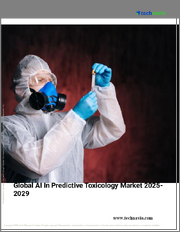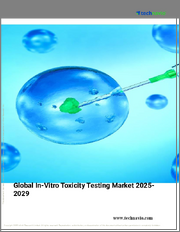
|
시장보고서
상품코드
1454741
세계의 체외 독성 시험 시장 : 제품 및 서비스, 종말점 및 시험, 기술, 방법, 산업별 예측(2024-2032년)In-vitro Toxicology Testing Market - Product and Services, Endpoint and Test, Technology, Method, Industry - Global Forecast, 2024 - 2032 |
||||||
체외 독성 시험 시장 규모는 2024년부터 2032년까지 연평균 7.7% 이상의 성장률을 보일 것으로 예상됩니다. 이는 주로 윤리적 우려와 규제 압력으로 인해 동물 실험보다 in-vitro 방법의 채택이 증가하고 있기 때문입니다. 화학물질이 인체에 미치는 악영향에 대한 인식 증가와 세포 배양 기술의 발전은 시험관 내 시험의 매력을 가속화하고 있습니다.
최근 의약품, 화장품, 화학물질 등 다양한 산업에서 의약품 개발 시 안전성 평가와 화학물질의 위험성 평가에 대한 중요성이 강조되고 있습니다. 독성학 연구에 대한 자금 지원과 하이스루풋 스크리닝 분석법 개발로 in-vitro 독성 시험 솔루션의 활용은 더욱 증가할 것으로 보입니다. 예를 들어, 알티스 바이오시스템즈는 2023년 8월 인간 유래 결장 염증 체외 모델을 사용하여 염증성 장질환(IBD) 신약 개발을 강화하기 위해 RepliGut(R) Planar InflammaScreen(TM) 서비스를 시작했습니다.
체외 독성 시험 산업은 제품 및 서비스, 엔드포인트 및 시험, 기술, 방법, 산업, 지역으로 분류됩니다.
제품 및 서비스 측면에서 고처리량 스크리닝 분석에 대한 수요가 증가함에 따라 2024년부터 2032년까지 8%의 성장률로 분석 분야 시장 규모가 확대될 것으로 예상됩니다. 분석 기술의 발전으로 보다 정확하고 신뢰할 수 있는 결과를 얻을 수 있게 되었습니다. 특정 독성학적 엔드포인트에 특화된 분석법 개발에 대한 관심이 높아짐에 따라 in-vitro 시험의 보급이 확대될 것으로 보입니다. 또한, 다양한 용도에 맞는 다양한 분석 키트와 서비스를 이용할 수 있다는 점도 이 분야의 성장에 도움이 될 것입니다.
유전독성 분야의 체외독성시험 산업은 평가지표 및 시험 측면에서 2024년부터 2032년까지 연평균 8%의 성장률을 나타낼 전망입니다. 그 배경에는 유전독성 테스트 방법의 발전, 다양한 산업에서 유전독성 화합물에 대한 규제 모니터링 강화, 유전독성 물질과 관련된 잠재적 위험에 대한 인식이 높아졌기 때문입니다. 유전독성 평가를 위한 새로운 분석법 및 시험 전략의 개발도 유전독성 시험에서 시험관 내 시험에 대한 수요를 증가시킬 것으로 보입니다.
지역별로 보면, 아시아태평양의 체외독성시험 시장은 예측 기간 동안 8.2%의 성장률을 보일 것으로 예상됩니다. 이는 산업화의 발전, 의약품 개발 및 화학물질 안전성 평가에서 독성 시험의 중요성에 대한 인식 증가, 제품 안전에 대한 규제 지침의 강화에 기인합니다. 제약 및 생명공학 부문의 연구개발 활동의 활성화와 헬스케어 인프라의 확대는 이 지역의 체외독성시험 솔루션 채택을 촉진할 것으로 보입니다.
목차
제1장 조사 방법과 조사 범위
제2장 주요 요약
제3장 업계 인사이트
- 생태계 분석
- 업계에 대한 영향요인
- 성장 촉진요인
- 업계의 잠재적 리스크&과제
- 성장 가능성 분석
- 기술적 전망
- Porter's Five Forces 분석
- PESTEL 분석
제4장 경쟁 구도
- 서론
- 기업 매트릭스 분석
- 기업 점유율 분석
- 경쟁 포지셔닝 매트릭스
- 전략 대시보드
제5장 시장 추산·예측 : 제품 및 서비스별
- 주요 동향
- 소모품
- 어세이
- 세균 독성 어세이
- 효소 독성 어세이
- 세포 기반 ELISA 및 웨스턴 블로팅
- 수용체 결합 어세이
- 조직배양 어세이
- 기타 어세이
- 설비
- 소프트웨어
- 서비스
제6장 시장 추산·예측 : 평가 항목 및 시험별
- 주요 동향
- 흡수/분포/대사/배설(ADME)
- 피부 자극성/부식성/감작성
- 유전 독성
- 세포 독성
- 눈 독성
- 장기 독성
- 광독성
- 경피 독성
- 기타 평가항목 및 시험
제7장 시장 추산·예측 : 기술별
- 주요 동향
- 세포배양
- High throughput
- Toxicogenomics
제8장 시장 추산·예측 : 방법별
- 주요 동향
- 세포 어세이
- 생화학 어세이
- 인실리코 모델
- 생체외 모델
제9장 시장 추산·예측 : 산업별
- 주요 동향
- 의약품 및 바이오의약품
- 화장품 및 가정용품
- 식품
- 화학제품
제10장 시장 추산·예측 : 지역별
- 주요 동향
- 북미
- 미국
- 캐나다
- 유럽
- 독일
- 영국
- 프랑스
- 스페인
- 이탈리아
- 기타 유럽
- 아시아태평양
- 일본
- 중국
- 인도
- 호주
- 한국
- 기타 아시아태평양
- 라틴아메리카
- 브라질
- 멕시코
- 아르헨티나
- 기타 라틴아메리카
- 중동 및 아프리카
- 남아프리카공화국
- 사우디아라비아
- 아랍에미리트(UAE)
- 기타 중동 및 아프리카
제11장 기업 개요
- Abbott Laboratories
- Agilent Technologies, Inc.
- Bio-Rad Laboratories, Inc.
- Catalent, Inc.
- Charles River Laboratories International, Inc.
- Danaher Corporation
- Eurofins Scientific
- Evotec S.E.
- Laboratory Corporation of America Holdings
- Merck KGaA
- Quest Diagnostics Incorporated
- SGS Societe Generale de Surveillance SA
- Thermo Fisher Scientific Inc.
In-vitro Toxicology Testing Market size is predicted to expand at over 7.7% CAGR from 2024 to 2032, mainly led by the increasing adoption of in-vitro methods over animal testing due to ethical concerns and regulatory pressures. The rising awareness about the adverse effects of chemicals on human health and the developments in cell culture technologies are accelerating the appeal of in-vitro testing.
Lately, there has been growing emphasis on safety assessment during drug development and chemical risk assessment in various industries, such as pharmaceuticals, cosmetics, and chemicals. The availability of funding for research in toxicology and the development of high-throughput screening assays will further increase the utilization of in-vitro toxicology testing solutions. For instance, in August 2023, Altis Biosystems launched RepliGut(R) Planar InflammaScreen(TM) Services to enhance drug discovery for inflammatory bowel diseases (IBD) using a human-derived in vitro model of colon inflammation.
The in-vitro toxicology testing industry is segregated into product and services, endpoint and test, technology, method, industry, and region.
With respect to product and services, the market size from the assays segment will rise at 8% growth rate from 2024 to 2032, on account of the increasing demand for high-throughput screening assays. Rising advancements in assay technologies are allowing for more accurate and reliable results. The growing focus on developing specialized assays for specific toxicological endpoints will increase the penetration of in-vitro testing. The availability of a wide range of assay kits and services tailored to different applications will also drive the segment growth.
In terms of endpoint and test, the in-vitro toxicology testing industry from the genotoxicity segment is anticipated to rise at 8% CAGR from 2024 to 2032. This is due to the advancements in genotoxicity testing methods, increased regulatory scrutiny on genotoxic compounds in various industries, and the growing awareness about the potential hazards associated with genotoxic substances. The development of novel assays and testing strategies for assessing genotoxicity will also increase the demand for in-vitro testing in genotoxicity testing.
Regionally, the Asia Pacific in-vitro toxicology testing market will depict 8.2% growth rate during the projected timeframe. This can be attributed to the increasing industrialization, rising awareness about the importance of toxicity testing in drug development and chemical safety assessment, as well as stringent regulatory guidelines for product safety. The growing R&D activities in pharmaceutical and biotechnology sectors along with the expanding healthcare infrastructure will stimulate the adoption for in-vitro toxicology testing solutions in the region.
Table of Contents
Chapter 1 Methodology & Scope
- 1.1 Market scope & definitions
- 1.2 Base estimates & calculations
- 1.3 Data collection
- 1.4 Forecast calculations
- 1.5 Data validation
- 1.6 Data sources
- 1.6.1 Primary
- 1.6.2 Secondary
- 1.6.2.1 Paid sources
- 1.6.2.2 Unpaid sources
Chapter 2 Executive Summary
- 2.1 Industry 360 degree synopsis
Chapter 3 Industry Insights
- 3.1 Industry ecosystem analysis
- 3.2 Industry impact forces
- 3.2.1 Growth drivers
- 3.2.1.1 Rise in government funding for toxicology research
- 3.2.1.2 Increased R&D investments
- 3.2.1.3 Technological advancements
- 3.2.1.4 Growing resistance against animal testing
- 3.2.2 Industry pitfalls & challenges
- 3.2.2.1 Stringent regulatory restrictions
- 3.2.2.2 Lack of in-vitro models to study complex end-points
- 3.2.1 Growth drivers
- 3.3 Growth potential analysis
- 3.4 Technological landscape
- 3.5 Porter's analysis
- 3.5.1 Supplier power
- 3.5.2 Buyer power
- 3.5.3 Threat of new entrants
- 3.5.4 Threat of substitutes
- 3.5.5 Industry rivalry
- 3.6 PESTEL analysis
Chapter 4 Competitive Landscape, 2023
- 4.1 Introduction
- 4.2 Company matrix analysis
- 4.3 Company market share analysis
- 4.4 Competitive positioning matrix
- 4.5 Strategy dashboard
Chapter 5 Market Estimates and Forecast, By Product and Services, 2018 - 2032 ($ Mn)
- 5.1 Key trends
- 5.2 Consumables
- 5.3 Assays
- 5.3.1 Bacterial toxicity assays
- 5.3.2 Enzyme toxicity assays
- 5.3.3 Cell-based ELISA and western blots
- 5.3.4 Receptor binding assays
- 5.3.5 Tissue culture assays
- 5.3.6 Others assays
- 5.4 Equipment
- 5.5 Software
- 5.6 Services
Chapter 6 Market Estimates and Forecast, By Endpoint and Test, 2018 - 2032 ($ Mn)
- 6.1 Key trends
- 6.2 Absorption, distribution, metabolism, and excretion (ADME)
- 6.3 Skin irritation, corrosion, sensitization
- 6.4 Genotoxicity
- 6.5 Cytotoxicity
- 6.6 Ocular toxicity
- 6.7 Organ toxicity
- 6.8 Phototoxicity
- 6.9 Dermal toxicity
- 6.10 Other endpoints and tests
Chapter 7 Market Estimates and Forecast, By Technology, 2018 - 2032 ($ Mn)
- 7.1 Key trends
- 7.2 Cell culture
- 7.3 High throughput
- 7.4 Toxicogenomics
Chapter 8 Market Estimates and Forecast, By Method, 2018 - 2032 ($ Mn)
- 9.1 Key trends
- 9.2 Cellular assays
- 9.3 Biochemical assays
- 9.4 In silico models
- 9.5 Ex vivo models
Chapter 9 Market Estimates and Forecast, By Industry, 2018 - 2032 ($ Mn)
- 8.1 Key trends
- 8.2 Pharmaceuticals and biopharmaceuticals
- 8.3 Cosmetics and household products
- 8.4 Food
- 8.5 Chemicals
Chapter 10 Market Estimates and Forecast, By Region, 2018 - 2032 ($ Mn)
- 10.1 Key trends
- 10.2 North America
- 10.2.1 U.S.
- 10.2.2 Canada
- 10.3 Europe
- 10.3.1 Germany
- 10.3.2 UK
- 10.3.3 France
- 10.3.4 Spain
- 10.3.5 Italy
- 10.3.6 Rest of Europe
- 10.4 Asia Pacific
- 10.4.1 Japan
- 10.4.2 China
- 10.4.3 India
- 10.4.4 Australia
- 10.4.5 South Korea
- 10.4.6 Rest of Asia Pacific
- 10.5 Latin America
- 10.5.1 Brazil
- 10.5.2 Mexico
- 10.5.3 Argentina
- 10.5.4 Rest of Latin America
- 10.6 Middle East and Africa
- 10.6.1 South Africa
- 10.6.2 Saudi Arabia
- 10.6.3 UAE
- 10.6.4 Rest of Middle East and Africa
Chapter 11 Company Profiles
- 11.1 Abbott Laboratories
- 11.2 Agilent Technologies, Inc.
- 11.3 Bio-Rad Laboratories, Inc.
- 11.4 Catalent, Inc.
- 11.5 Charles River Laboratories International, Inc.
- 11.6 Danaher Corporation
- 11.7 Eurofins Scientific
- 11.8 Evotec S.E.
- 11.9 Laboratory Corporation of America Holdings
- 11.10 Merck KGaA
- 11.11 Quest Diagnostics Incorporated
- 11.12 SGS Societe Generale de Surveillance SA
- 11.13 Thermo Fisher Scientific Inc.



















